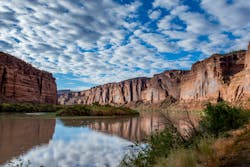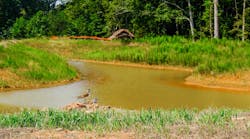Garth Englehorn is senior project manager with NV5. Engelhorn can be reached at [email protected].
undefinedThe last two decades have shown us that the West Coast is constantly bouncing between wet and dry periods. Our dry years are getting drier, our wet years are getting wetter and multi-year droughts are often only separated by a few above average wet years. These precipitation extremes create drought and flooding concerns. With less frequent precipitation, we are increasingly reliant on a few large storm events to make up our annual precipitation. It is from these large winter storms, often in the form of atmospheric rivers, that we recharge our water supplies. However, they can create major flooding events and destructive debris flows can be triggered by intense rainfall over areas of recent wildfires.
After the last two years of dry conditions, California is 100% in moderate-to-exceptional drought. Extreme to exceptional drought continued to expand across most of central and northern California in August. The reservoirs throughout California are low, and the wildfire risks are evident by the large wildfires burning throughout California. And as I wrote back in May, the current drought rapidly increased in coverage and intensity fueled by last year’s record setting heat waves and lack of moisture over the 2020-2021 winter. The Southwest (California, Nevada, Arizona, Utah, Colorado, New Mexico) appeared to be headed towards a significant and prolonged drought. There is some good news to report since May, due to recent summer monsoonal rainfall, the drought conditions improved in northern Arizona, New Mexico, southern Utah, and parts of southern Nevada and southeast California.
The long range forecast for the next three months indicate that drought will persist across California and the Southwest, where above-normal temperatures are forecast to continue across most of the West. The most recent forecasts indicate a potential for La Niña development during the fall and persisting through the winter, which is typically associated with dry winter conditions in parts of California. A dominant ridge of high pressure in the Eastern Pacific Ocean will allow temperatures to trend above normal and rainfall to be below normal as the majority of low pressure systems are forecast to head to the Pacific Northwest instead of California. In summary, the forecast through December indicates above normal temperatures, below normal rainfall, and near normal amount of Santa Ana wind events. Drought impacts, such as wildfires and lack of water supply will continue to expand and intensify if this pattern continues.
As storm water professionals, we play a large role in curbing the impacts of this drought and simultaneously preparing our communities for the potential of large storm events. We are supporting our local, state and federal government agencies with programs to improve drought preparedness and water resiliency. We are educating our communities and businesses on the importance in water conservation and water recycling. In recent developments, the Bureau of Reclamation declared the first-ever shortage on the Colorado River and the Metropolitan Water declared a Water Supply Alert, calling for consumers and businesses to voluntarily reduce their water use and help preserve the region’s storage reserves. We actively engage with our local and state governments to advocate for projects that will increase water resiliency, reduce reliance on imported water, and protect local water resources. Our storm water engineers are finding many innovative ways to capture the storm water we receive. However, a consistent maintenance program is the best way to ensure that any storm water capture feature will continue to perform its water quality and flow reduction functions. With the trend to less frequent and larger precipitation events, it is imperative that storm water capture features function properly and do not fail when they are needed the most. A maintenance program consists of regular inspections, debris and litter control, vegetation management, sediment removal and stabilization.
We are helping communities and businesses ensure they have procedures for evacuation and contingency planning for fires and floods. We know that wildfires are burning across California, and the last two decades have shown us we need to plan for less frequent and intense storms. And if an atmospheric river event brings intense rainfall over an area where major wildfires have burned, then fast-moving, highly destructive debris flows can be triggered. In 2018, following the Thomas Fire, the Montecito debris flows caused 21 fatalities, destroyed more than 100 homes, and shut down Highway 101. An atmospheric river in January of 2021 produced heavy rains upwards of 15 inches in some areas of central California leading to flooding and mudslides in areas burned by wildfires in 2020, damaging homes, businesses and infrastructure. This upcoming winter may be wet, it may be dry, but either way we will be busy implementing post-fire mitigation solutions and conducting water quality monitoring programs to protect our communities and our local water resources.
As storm water professionals, we stand prepared for fires, floods, droughts or climate-related events that winter will bring.






